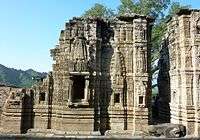Kangra Fort
The Kangra Fort is located 20 kilometers from the town of Dharamsala on the outskirts of the town of Kangra, India.
| Kangra Fort | |
|---|---|
| Part of Himachal Pradesh | |
| Dharamsala, Himachal Pradesh, India | |
Kangra Fort | |
| Type | Fort |
| Site information | |
| Controlled by | Government of Himachal Pradesh |
| Condition | Ruins |
| Site history | |
| Built by | Rajput family of Kangra State (the Katoch dynasty) |
| Materials | Granite Stones and lime mortar |
History
The Kangra Fort was built by the royal Rajput family of Kangra State (the Katoch dynasty), which traces its origins to the ancient Trigarta Kingdom, mentioned in the Mahabharata epic. It is the largest fort in the Himalayas and probably the oldest dated fort in India.
At least three rulers sought to conquer the fort and plundered the treasures of its temples: Mahmud Ghazni in 1009, Firuz Shah Tughluq in 1360 and Sher Shah in 1540.[1] The fort of Kangra resisted Akbar's siege. Akbar's son Jahangir successfully subdued the fort in 1620.[2] Kangra was at the time ruled by Raja Hari Chand Katoch of Kangra (also known as Raja Hari Chand II)[3] Mughal Emperor Jahangir with the help of Suraj Mal garrisoned with his troops. Under Jahangir, Murtaza Khan the governor of Punjab was directed to conquer Kangra, but he failed on account of the jealousy and opposition of the Rajput chiefs who were associated with him. Then Prince Khurram was put in charge of the command. The siege of Kangra was pushed on for weeks. Supplies were cut off. The garrison had to live on boiled dry grass. It was faced with death and starvation. After a siege of 14 months, the fort surrendered in November, 1620. In 1621, Jahangir visited it and ordered the slaughter of a bullock there.[4] A mosque was also built within the fort of Kangra.[5]
The Katoch Kings repeatedly looted Mughal controlled regions, weakening the Mughal control, aiding in the decline of Mughal power, Raja Sansar Chand II succeeded in recovering the ancient fort of his ancestors, in 1789. Maharaja Sansar Chand fought multiple battles with Gurkhas on one side and Sikh King Maharaja Ranjit Singh on the other. Sansar Chand used to keep his neighboring Kings jailed, and this led to conspiracies against him. During a battle between the Sikhs and Katochs, the gates of the fort had been kept open for supplies.
The Gorkhali army entered the opened scarcely armed gates in 1806. This forced an alliance between Maharaja Sansar Chand and Maharaja Ranjit Singh. Because of the insufficiency of the need within the fort after a long Gurkha-Sikh War and unable to procure any, the Gurkhas left the Fort. The Fort remained with the Katochs until 1828 when Ranjit Singh annexed it after Sansar Chand's death. The fort was finally taken by the British after the Sikh war of 1846.
A British garrison occupied the fort until it was heavily damaged in an earthquake on 4 April 1905.
 Laxmi Narayan Temple, Kangra Fort
Laxmi Narayan Temple, Kangra Fort Statue of Rishabhnatha inside the Ambika Mata Temple at top of Kangra Fort
Statue of Rishabhnatha inside the Ambika Mata Temple at top of Kangra Fort.jpg) Jain temple inside fort
Jain temple inside fort
Layout
The entrance to the fort is through a small courtyard enclosed between two gates which were built during the Sikh period, as appears from an inscription over the entrance. From here a long and narrow passage leads up to the top of the fort, through the Ahani and Amiri Darwaza (gate), both attributed to Nawab Saif Ali Khan, the first Mughal Governor of Kangra. About 500 feet from the outer gate the passage turns round at a very sharp angle and passes through the Jehangiri Darwaza.
The Darsani Darwaza, which is now flanked by defaced statues of River Goddesses Ganga and Yamuna gave access to a courtyard, along the south side of which stood the stone shrines of Lakshmi-Narayana and Ambika Devi and a Jain temple with large idol of Rishabhanatha.[6]
Location

The fort is right next to Kangra town. 32.1°N 76.27°E The fort stands on a steep rock in Purana Kangra (translates to Old Kangra) dominating the surrounding valley, built strategically at the "Sangam" confluence (places where two rivers meet) of Banganga and Majhi rivers. It is said that Kangra belongs to one who owns the fort.
Also near to old Kangra is the famous Jayanti Mata temple on a hilltop. The Temple was built by the General of the Gorkha Army, Bada Kaji Amar Singh Thapa. Also close to entrance is a small museum which exhibits the history of Kangra fort.
Adjoining the Fort is the Maharaja Sansar Chand Katoch Museum run by the Royal Family of Kangra. The Museum also provides audio guides for the fort and the museum and has a cafeteria.
References
- Narayan, Kirin (22 November 2016). Everyday Creativity: Singing Goddesses in the Himalayan Foothills. ISBN 9780226407562.
- Sen, Sailendra (2013). A Textbook of Medieval Indian History. Primus Books. pp. 165–166. ISBN 978-9-38060-734-4.
- Hutchison, John (2008). History of the Panjab Hill States, Volume 1. Asian Educational Services (First ed 1913) Ed. 2008. pp. 200–225. ISBN 978-8175364400.
- http://www.preservearticles.com/2012031026090/jahangirs-conquest-of-kangra-and-kistwar.html
- "7". Kangra. Ekaant (in Hindi). 2015. EPIC.
- Jeratha, Aśoka (2000), Forts and Palaces of the Western Himalaya, Indus Publishing, p. 31, ISBN 9788173871047
Further reading
| Wikimedia Commons has media related to Kangra Fort. |
- Hutchinson, J. & J. PH Vogel (1933). History of the Panjab Hill States, Vol. I. 1st edition: Govt. Printing, Lahore, Punjab, Pakistan. 1933. Reprint 2000. Department of Language and Culture, Himachal Pradesh. Chapter IV Kangra State, pp. 98–198.
- Royal Family of Kangra and the Durbar-e-Amm museum society. Kangra. Date unknown. Purchased in 2010 in Kangra.